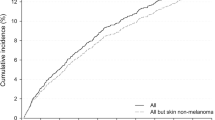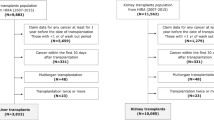Abstract
Background
Kidney transplant recipients (KTR) are known to have a higher risk of cancer than the general population, especially of malignancies related to oncogenic viral infections. This study assessed the incidence of de novo malignancies (DNMs) in patients receiving kidney transplantation and in dialysis patients (DP) on the waiting list for transplantation at the same centre. The aim was to quantify the contribution of post-transplant immunosuppression to the underlying risk of developing a DNM in dialysis patients on the waiting list for kidney transplant.
Methods
Cancer incidence rates were computed using the Kaplan–Meier product-limit method. The number of DNMs observed in both groups was compared to the expected incidence in the general Italian population through calculation of the standardized incidence ratios (SIR) and their 95% confidence intervals (CI). To identify risk factors, incidence rate ratios (IRR) and 95% CIs were computed using Poisson regression analysis. The comparison of incidence rates between the two cohorts was also performed using age standardized incidence rates (ASR) and their ratio (age standardized rate ratio, ASRR).
Results
In 4858 person-years (PYs) of observation, 75 out of 735 KTR were diagnosed with DNM: 57 solid neoplasms, 13 post-transplant lymphoproliferative disorders (PTLD), and 12 Kaposi sarcomas (KS). The overall incidence was 17.5 cases/103 PYs, resulting in a 2.1-fold increased risk. Twenty-four out of 912 DP, over a follow-up of 2400 PYs, were diagnosed with a solid neoplasm, but none had PTLD or KS. The use of induction therapy after transplant was associated with a significant increased risk of KS (IRR: 3.52; 95% CI 1.04–11.98, p < 0.05). ASRR for all cancers and for solid cancers only was 1.84- and 1.19-fold higher in KTR, respectively, than in the general population. The overall incidence in DP was 10.0 cases/103 PYs, with a 1.6 significantly increased cancer risk compared to the general population.
Conclusion
Our study confirms the increased risk of cancer after transplantation and during dialysis, but showed that virus-related cancers only occur after post-transplant immunosuppression.

Similar content being viewed by others
References
Buell JF, Gross TG, Woodle S (2005) Malignancy after transplantation. Transplantation 80:S254–S264
Morath C, Mueller M, Goldschmidt H, Schwenger V, Opelz G, Zeier M (2004) Malignancy in renal transplantation. J Am Soc Nephrol 15:1582–1588
Piselli P, Busnach G, Fratino L et al (2013) De Novo malignancies after organ transplantation: focus on viral infections. Curr Mol Med 13:1217–1227
Ponticelli C, Cucchiari D, Bencini P (2014) Skin cancer in kidney transplant recipients. J Nephrol 27:385–394
Piselli P, Serraino D, Segoloni GP et al (2013) Risk of de novo cancer after transplantation: results from a cohort of 7217 kidney transplant recipients, Italy 1997–2009. Eur J Cancer 49:336–344
World Health Organization. 1992. The ICD-10 classification of mental and behavioural disorders: clinical descriptions and diagnostic guidelines. World Health Organization, Geneva
Goodwin RG, Holme SA, Roberts DL (2004) Variation of registration of skin cancer in the United Kingdom. Clin Exp Dermatol 29:328–330
Breslow NE, Day NE (1987) The design and analysis of cohort studies. In: Heseline E (ed) Statistical methods in cancer research. International Agency for Research on Cancer Scientific Publications, Lyon, pp 2–391
Curado MP, Edwards B, Shin HR et al (2007) Cancer Incidence in Five Continents, vol. IX. IARC Sci Publ No. 160. IARC Press, Lyon
AIRTUM, ITACAN (2017) Cancer in Italy, Version 2.0. Italian Association of Cancer Registries (http://www.registri-tumori.it)
Cislaghi C (2009) Effective and effortless data standardization. Epidemiol Prev 33:190–192
Maissonneuve P, Agodoa L, Gellert R et al (1999) Cancer in patient on dialysis for end-stage renal disease: an international collaborative study. Lancet 354:93–99
Birkeland SA, Løkkegaard H, Storm HH (2000) Cancer risk in patients on dialysis and after renal transplantation. Lancet 355:1886–1887
Vajdic CM, McDonald SP, McCredie MRE et al (2006) Cancer incidence before and after kidney transplantation. JAMA 296:2823–2831
Centro Nazionale Trapianti; http://www.trapianti.salute.gov.it. Accessed 8 Mar 2017
Van Leeuwen MT, Webster AC, McCredie MR et al (2010) Effect of reduced immunosuppression after kidney transplant failure on risk of cancer: population based retrospective cohort study. BMJ 340:c570
Van Leeuwen MT, Grulich AE, McDonald SP et al (2009) Immunosuppression and other risk factors for lip cancer after kidney transplantation. Cancer Epidemiol Biomark Prev 18:561–569
Opelz G, Döhler B (2004) Lymphomas after solid organ transplantation: a collaborative transplant study report. Am J Transplant 4:222–230
Hosseini-Moghaddam SM, Soleimanirahbar A, Mazzulli T, Rotstein C, Husain S (2012) Post renal transplantation Kaposi’s sarcoma: a review of its epidemiology, pathogenesis, diagnosis, clinical aspects, and therapy. Transpl Infect Dis 14:338–345
Lowrance WT, Ordoñez J, Udaltsova N, Russo P, Go AS (2014) CKD and the risk of incident cancer. J Am Soc Nephrol 25:2327–2334
Frascà GM, Sandrini S, Cosmai L et al (2015) Renal cancer in kidney transplanted patients. J Nephrol 28:659–668
Acknowledgements
This study was supported by the “Associazione Italiana per la Ricerca sul Cancro-AIRC, Milan, Italy”; Ministero della Salute, Ricerca Finalizzata and Programma di Ricerca Corrente IRCCS INMI Spallanzani, Rome, Italy and IRCCS Centro di Riferimento Oncologico, Aviano (PN), Italy.
Author information
Authors and Affiliations
Corresponding author
Ethics declarations
Conflict of interest
None of the authors declare conflict of interest.
Ethical approval
The study was approved in 2012 by the Ethical Committee of Centro di Riferimento Oncologico di Aviano, the Institution of the PI of the overall research proposal.
Informed consent
Informed consent was obtained from all individual participants included in the study.
Rights and permissions
About this article
Cite this article
Mazzucotelli, V., Piselli, P., Verdirosi, D. et al. De novo cancer in patients on dialysis and after renal transplantation: north-western Italy, 1997–2012. J Nephrol 30, 851–857 (2017). https://doi.org/10.1007/s40620-017-0385-y
Received:
Accepted:
Published:
Issue Date:
DOI: https://doi.org/10.1007/s40620-017-0385-y




